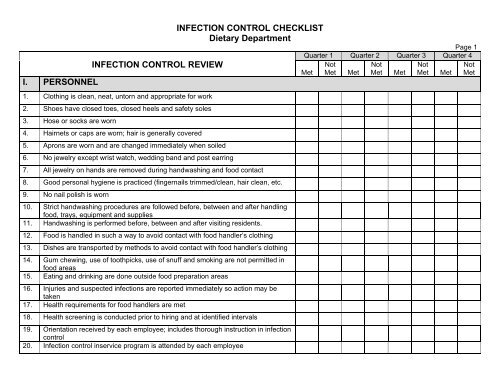INFECTION CONTROL CHECKLIST Dietary Department ...
INFECTION CONTROL CHECKLIST Dietary Department ...
INFECTION CONTROL CHECKLIST Dietary Department ...
You also want an ePaper? Increase the reach of your titles
YUMPU automatically turns print PDFs into web optimized ePapers that Google loves.
I. PERSONNEL<br />
<strong>INFECTION</strong> <strong>CONTROL</strong> REVIEW<br />
1. Clothing is clean, neat, untorn and appropriate for work<br />
2. Shoes have closed toes, closed heels and safety soles<br />
3. Hose or socks are worn<br />
4. Hairnets or caps are worn; hair is generally covered<br />
5. Aprons are worn and are changed immediately when soiled<br />
6. No jewelry except wrist watch, wedding band and post earring<br />
<strong>INFECTION</strong> <strong>CONTROL</strong> <strong>CHECKLIST</strong><br />
<strong>Dietary</strong> <strong>Department</strong><br />
7. All jewelry on hands are removed during handwashing and food contact<br />
8. Good personal hygiene is practiced (fingernails trimmed/clean, hair clean, etc.<br />
9. No nail polish is worn<br />
10. Strict handwashing procedures are followed before, between and after handling<br />
food, trays, equipment and supplies<br />
11. Handwashing is performed before, between and after visiting residents.<br />
12. Food is handled in such a way to avoid contact with food handler’s clothing<br />
13. Dishes are transported by methods to avoid contact with food handler’s clothing<br />
14. Gum chewing, use of toothpicks, use of snuff and smoking are not permitted in<br />
food areas<br />
15. Eating and drinking are done outside food preparation areas<br />
16. Injuries and suspected infections are reported immediately so action may be<br />
taken<br />
17. Health requirements for food handlers are met<br />
18. Health screening is conducted prior to hiring and at identified intervals<br />
19. Orientation received by each employee; includes thorough instruction in infection<br />
control<br />
20. Infection control inservice program is attended by each employee<br />
Page 1<br />
Quarter 1 Quarter 2 Quarter 3 Quarter 4<br />
Not<br />
Not<br />
Not<br />
Not<br />
Met Met Met Met Met Met Met Met
II.<br />
<strong>INFECTION</strong> <strong>CONTROL</strong> REVIEW<br />
FOOD PREPARATION AND SERVING<br />
<strong>INFECTION</strong> <strong>CONTROL</strong> <strong>CHECKLIST</strong><br />
<strong>Dietary</strong> <strong>Department</strong><br />
1. Utensils/equipment used to prepare and serve food (direct use of hands is<br />
avoided)<br />
2. The two-spoon method is used for taste-testing food<br />
3. Food is held at proper temperature during storage and service<br />
4. Expired products immediately separated from general storage and returned for<br />
credit or destroyed; no out-of-date products are used<br />
5. Served food is covered (individually or within closed carts) during transport<br />
6. Leftovers are discarded within 48 hours<br />
7. Refrigerated items are stored in covered containers with labels and dates<br />
8. Supplies stored at appropriate distance from floor and ceiling in all storage areas<br />
9. Dishwasher temperature (or PPM) are appropriate to ensure sanitation<br />
10. All dishes and utensils are thoroughly dried before put away or used<br />
11. Trash/garbage cans are lined with impermeable liners, covered and immediately<br />
emptied<br />
12. Waste receptacles have tightly closed lids and are kept closed<br />
13. Waste is stored and disposed of in a sanitary manner, protecting other products<br />
and areas from cross-contamination<br />
14. A cleaning schedule is followed for all equipment, floors and related equipment<br />
15. Cleaning/sanitizing agents used to comply with Infection Control Committee<br />
guidelines<br />
16. All surfaces and equipment are free of cracks, chipped paint or other potential<br />
sources of contamination of areas capable of harboring bacteria<br />
17. All drains and fans are functioning properly<br />
18. Clean, ready-to-use serviceware (dishes, flatware) are free of cracks, food<br />
particles, stains or chips<br />
19. Water pitchers are sanitized a minimum of three times per week<br />
Page 2<br />
Quarter 1 Quarter 2 Quarter 3 Quarter 4<br />
Not<br />
Not<br />
Not<br />
Not<br />
Met Met Met Met Met Met Met Met
<strong>INFECTION</strong> <strong>CONTROL</strong> REVIEW<br />
20. All equipment filters are cleaned weekly<br />
21. Light bulbs are covered<br />
22. Handwashing facilities are used for no other purpose<br />
<strong>INFECTION</strong> <strong>CONTROL</strong> <strong>CHECKLIST</strong><br />
<strong>Dietary</strong> <strong>Department</strong><br />
23. Each handwashing facility includes warm water, soap and a drying method<br />
24. Floors, walls and ceiling are washable or tolerant of being cleaned and sanitized<br />
25. Cutting boards/meat slicers/can openers are clean, free of bulid-up, in good<br />
repair<br />
26. Cutting boards/slicers cleaned between uses for different categories<br />
(poulty/beef)<br />
27. Refrigerators and freezers are clean and free of build-up<br />
28. Food and chemicals are stored separately<br />
III.<br />
ISOLATION<br />
1. There is established communication regarding special infection control<br />
precautions<br />
2. Employees know how to follow infection control procedures<br />
Page 3<br />
Quarter 1 Quarter 2 Quarter 3 Quarter 4<br />
Not<br />
Not<br />
Not<br />
Not<br />
Met Met Met Met Met Met Met Met


